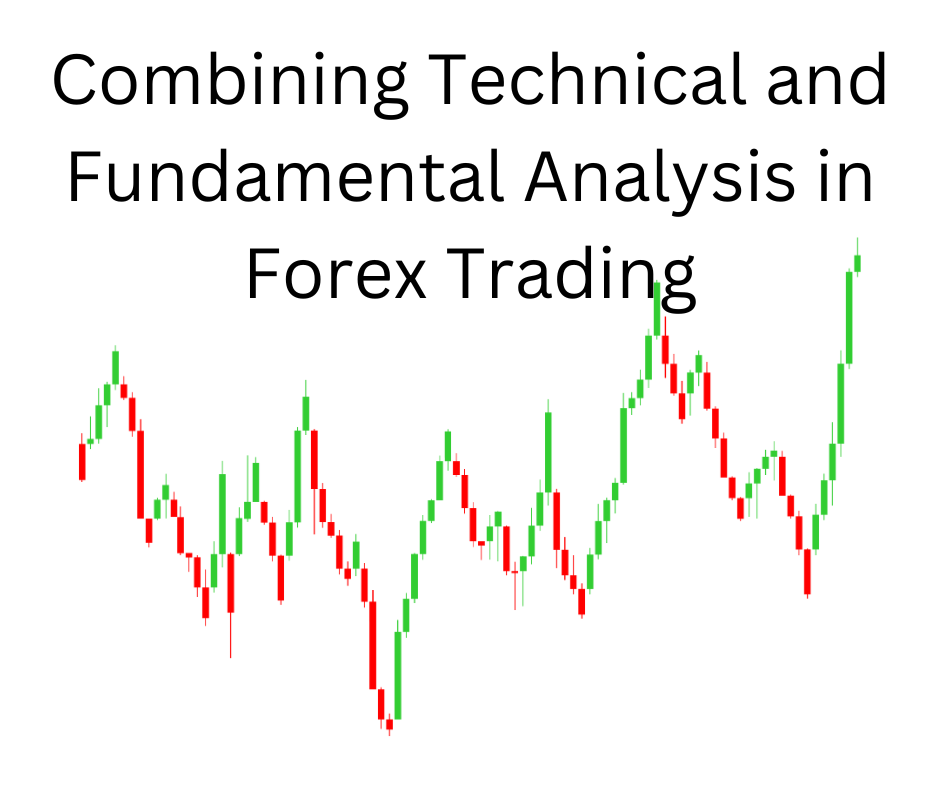When it comes to Forex trading, two primary approaches can be employed to analyze the market and make informed decisions. These are technical and fundamental analysis. While technical analysis focuses on historical price data and patterns, fundamental analysis examines the underlying economic factors that drive currency prices.
Importance of Combining the Two for Forex Trading
Each approach has its strengths and weaknesses, but combining them can provide a more comprehensive understanding of the market. By using both technical and fundamental analysis, you can gain a broader perspective and potentially improve your trading performance.

Understanding Technical Analysis
Technical analysis is a method used by traders to predict future price movements based on historical price data and patterns. It relies on the use of charts and various tools to identify trends, support and resistance levels, and other price patterns.
Types of Technical Analysis Tools: Trend Indicators, Oscillators, Support and Resistance Levels, and Chart Patterns
There are many tools and techniques available for technical analysis, some of which include:
- Trend indicators like moving averages, which help identify the overall direction of the market.
- Oscillators such as the Relative Strength Index (RSI) or the Stochastic Oscillator, which indicate overbought or oversold conditions.
- Support and resistance levels, which are horizontal lines drawn on the chart to identify areas where the price has historically struggled to move beyond.
- Chart patterns like head and shoulders, double tops and bottoms, or triangles, which help traders anticipate potential price movements based on historical patterns.
Examples of How Technical Analysis Tools Are Used in Forex Trading
For instance, you might use a moving average to determine the overall trend in a currency pair. If the price is above the moving average, the trend is considered bullish, and you may look for buying opportunities. Conversely, if the price is below the moving average, the trend is bearish, and you may look for selling opportunities.
Understanding Fundamental Analysis
Definition and Explanation of Fundamental Analysis
Fundamental analysis is the study of the underlying economic factors that influence currency prices. It involves examining economic indicators, news events, central bank announcements, and geopolitical events to assess the health of a country’s economy and its potential impact on its currency’s value.
Types of Fundamental Analysis Tools: Economic Indicators, News Events, Central Bank Announcements, and Geopolitical Events
Key tools and sources for fundamental analysis include:
- Economic indicators like GDP, inflation, and employment data, which provide insight into a country’s economic health.
- News events such as political developments or natural disasters, which can impact currency prices.
- Central bank announcements like interest rate decisions or monetary policy statements, which can have significant effects on currency values.
- Geopolitical events like trade wars or international conflicts, which can create uncertainty in the markets and influence currency prices.
Examples of How Fundamental Analysis Tools Are Used in Forex Trading
A trader might use fundamental analysis to assess the potential impact of a central bank’s interest rate decision on a currency pair. If the central bank raises interest rates, the currency may appreciate in value due to increased demand for higher-yielding assets. Conversely, if the central bank lowers interest rates, the currency may depreciate in value as investors seek better returns elsewhere.
The Pros and Cons of Technical Analysis and Fundamental Analysis
Advantages and Disadvantages of Technical Analysis
Technical analysis has its benefits, such as:
- Objective approach: It relies on historical price data, making it less subjective than fundamental analysis.
- Wide range of tools: Numerous tools and techniques can be employed to analyze the market from various perspectives.
- Applicable to all timeframes: Technical analysis can be used on any timeframe, from intraday to long-term trading.
However, there are also some drawbacks:
- Lagging indicators: Many technical analysis tools are lagging, meaning they react to price movements rather than predict them.
- Limited scope: Technical analysis doesn’t account for external factors such as economic data or geopolitical events that can impact currency prices.
Advantages and Disadvantages of Fundamental Analysis
Fundamental analysis offers some advantages, including:
- Holistic view: It takes into account a wide range of factors that influence currency prices, providing a more comprehensive understanding of the market.
- Long-term perspective: Fundamental analysis often focuses on longer-term trends, which can be beneficial for longer-term traders and investors.
However, there are also some downsides:
- Subjective approach: The interpretation of economic data and events can be subjective, making it harder to develop a consistent methodology.
- Time-consuming: Analyzing a large number of economic indicators and news events can be time-consuming and complex.
How to Combine Technical and Fundamental Analysis
How to Use Technical Analysis to Identify Entry and Exit Points
Technical analysis can help you identify potential entry and exit points in the market. For example, you might use a combination of trend indicators and support and resistance levels to determine when to buy or sell a currency pair.
How to Use Fundamental Analysis to Confirm or Challenge Technical Analysis Signals
Fundamental analysis can be used to confirm or challenge the signals generated by your technical analysis. For instance, if your technical analysis indicates a potential buying opportunity, you might check for any upcoming economic releases or news events that could either support or contradict your analysis.
Popular Technical and Fundamental Analysis Strategies Used in Forex Trading
Some popular trading strategies that combine technical and fundamental analysis include:
- Trading the news: This involves using technical analysis to identify potential trade setups before a news release and then using fundamental analysis to gauge the market’s reaction to the news.
- Carry trade: This strategy involves buying a high-yielding currency and selling a low-yielding currency, using technical analysis to identify optimal entry and exit points and fundamental analysis to assess interest rate differentials between the two currencies.
- Swing trading: This medium-term trading approach often involves using technical analysis to identify trends and reversals and fundamental analysis to evaluate the underlying market sentiment.
Factors to Consider When Combining Technical and Fundamental Analysis
The Importance of Having a Trading Plan
Having a trading plan is essential when combining technical and fundamental analysis. Your trading plan should outline your trading goals, risk tolerance, preferred timeframes, and the specific tools and techniques you’ll use for both types of analysis.
Understanding Market Volatility
Market volatility can impact the effectiveness of your technical and fundamental analysis. It’s crucial to be aware of the potential impact of volatility on your trading and adjust your approach accordingly.
The Role of Risk Management When Combining the Two Approaches
Risk management is crucial in Forex trading, especially when combining technical and fundamental analysis. Set appropriate stop-loss and take-profit levels, and manage your position sizes to ensure you’re not risking too much on any single trade.
Advantages of Combining Technical and Fundamental Analysis in Forex Trading
When used together, technical and fundamental analysis can
offer several advantages for Forex traders, such as:
- Better market timing: Combining both approaches can help you identify optimal entry and exit points more effectively, improving your overall market timing.
- Increased accuracy of trades: Using technical and fundamental analysis together can increase the accuracy of your trading signals by providing additional confirmation or challenging your initial analysis.
- Improved risk management: A comprehensive understanding of the market can lead to better risk management, as you’re more likely to be aware of potential market-moving events and can adjust your trading plan accordingly.
Using Technical Analysis to Identify a Trend and Fundamental Analysis to Confirm the Direction of the Trend
For example, you might use technical analysis to identify a trend in a currency pair and then use fundamental analysis to confirm the direction of the trend by examining the underlying economic factors driving the price movement.
Combining Technical Analysis and Fundamental Analysis to Identify a Trading Opportunity During a News Event
Another example might involve using technical analysis to identify a potential trading opportunity during a news event and then using fundamental analysis to assess the market’s reaction to the news and determine whether the initial trade setup remains valid.
Using Technical Analysis to Identify a Trading Signal and Fundamental Analysis to Confirm the Strength of the Signal
You could also use technical analysis to generate a trading signal, such as a breakout or reversal, and then use fundamental analysis to confirm the strength of the signal by evaluating the overall market sentiment and economic factors influencing the currency pair.
Common Mistakes to Avoid When Combining Technical and Fundamental Analysis
When using both technical and fundamental analysis in your trading, it’s essential to avoid common mistakes like:
- Over-reliance on one approach over the other: Strive for a balanced approach, using both types of analysis to inform your trading decisions.
- Ignoring market sentiment and market psychology: Both market sentiment and psychology can play a significant role in price movements, so it’s crucial to consider these factors in your analysis.
- Failing to adjust the trading plan when market conditions change: Markets are dynamic, and your trading plan should be flexible enough to adapt to changing conditions.
Conclusion
In summary, combining technical and fundamental analysis can provide Forex traders with a more comprehensive understanding of the market and improve their trading performance.
By using both approaches and avoiding common mistakes, you can enhance your market timing, trade accuracy, and risk management.
FAQ
What is the difference between technical analysis and fundamental analysis?
Technical analysis is based on historical price data and patterns, while fundamental analysis focuses on the underlying economic factors that influence currency prices.
Which approach is better for Forex trading?
Both approaches have their strengths and weaknesses, but combining them can provide a more comprehensive understanding of the market and potentially improve your trading performance.
How do I know when to use technical analysis versus fundamental analysis?
Using both types of analysis together can help you identify trade opportunities and confirm or challenge your initial analysis. For instance, you might use technical analysis to identify a trend and fundamental analysis to confirm the direction of the trend.
How do I avoid over-analyzing the market when using a combination of the two approaches?
To avoid over-analyzing the market, focus on a few key technical and fundamental indicators that align with your trading style and goals. Develop a trading plan that outlines your preferred tools and techniques, and be disciplined in sticking to your plan.
